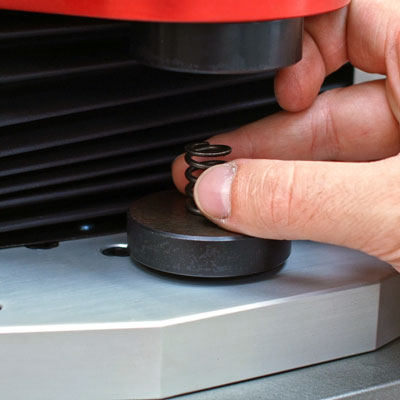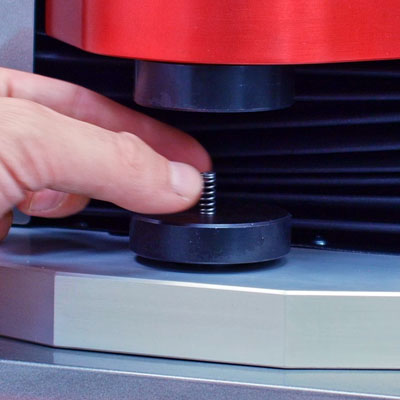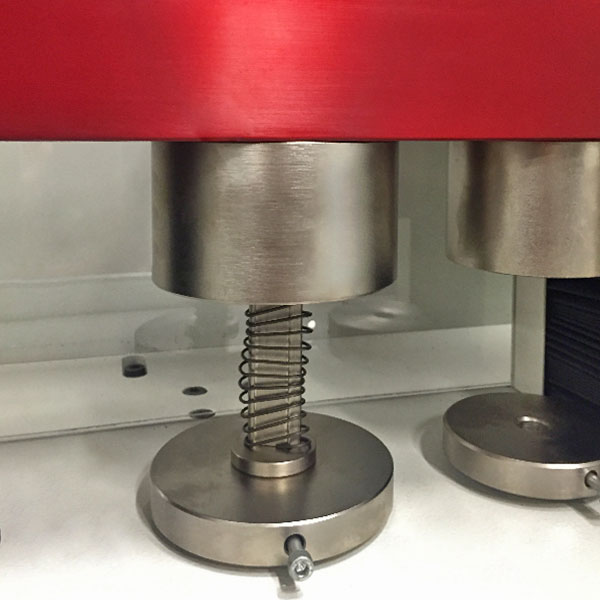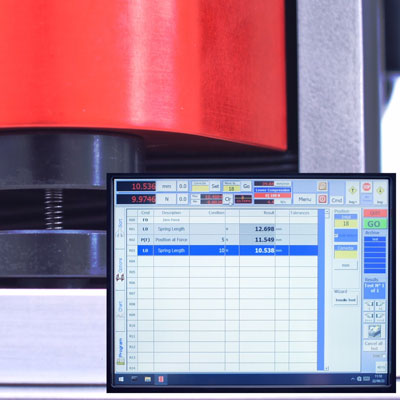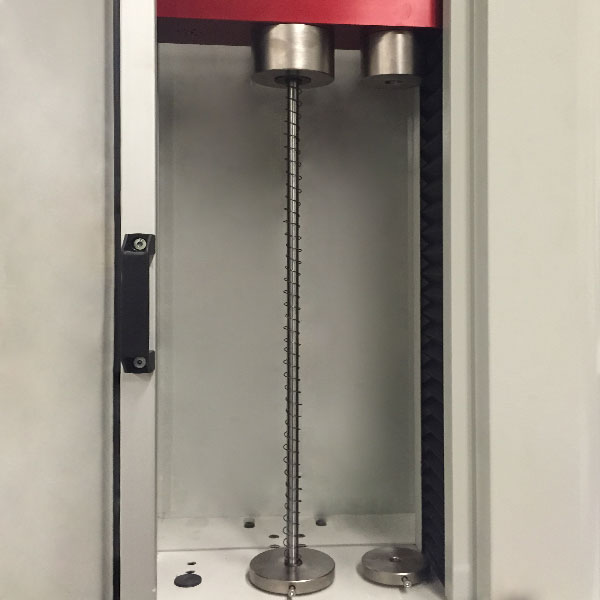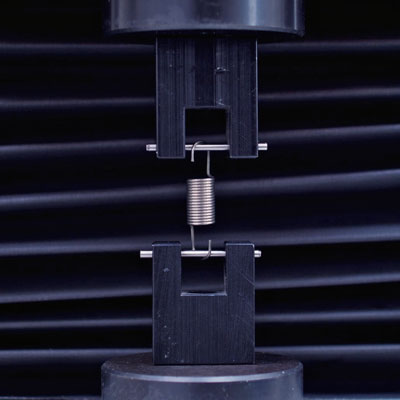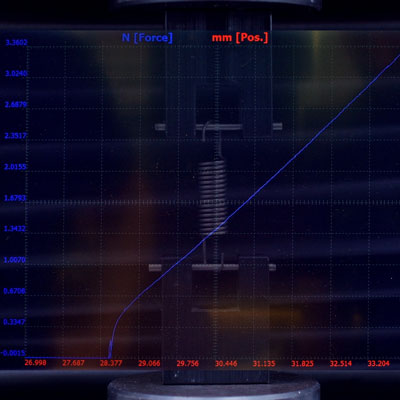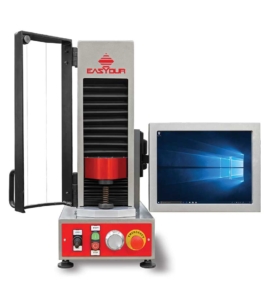
Microdyno is a modern, extremely compact bench spring load tester for low-load springs with a load capacity of up to 500 N (50 kg), and a load cell with 200.000 operative divisions. It is designed to perform a wide range of tests, starting with tensile tests (also to breaking point), going through compression tests (on materials and springs), to bending, shear and peeling tests.
Microdyno is presented here as a benchtop spring tester with automatic and motorised operation.
It’s a benchtop instrument for testing coil springs at particularly low loads (a feature that translates into extreme precision), which makes use of two plates (possibly with a through hole and compatible with one or more spring guide rods – we also produce kits) for compression tests, both on ground and unground springs, or dedicated hooks for tension springs with reduced forces, and which can also mount a scaled-down version of all Easydur accessories for tensile, bending and peeling tests at low loads of up to 500 N.
In this way, it is possible to test various materials, such as specimens, metal wires, plastics, rubbers, polymers and other similar materials.
In short: Microdyno can be fitted with customised grips to perform all kinds of tests on materials and springs, becoming truly universal (discover other configurations of Microdyno here).
One of the main advantages of Microdyno is its compact size, which allows it to be placed on the workbenches of companies operating in various sectors (from automotive to precision mechanics, from electrical engineering to medical) as well as in the laboratories of universities and research centres.
Like all Easydur machines, this benchtop spring load tester comes with a handy touch screen display that allows interfacing with the EasyQs testing software (for testing coil springs, components, switches and materials) developed entirely by Easydur.
Control possibilities are further supported by the front panel, with joystick, physical buttons and a hand control for precision micro-movements.
Main characteristics of the bench spring load testing machine
Versatile testing capabilities
Thanks to its versatility, Microdyno can perform accurate and repeatable tests on a variety of springs. Whether testing a spring with a low load and short initial length, or the load of a longer and heavier spring, up to 500 N, with a higher percentage elongation, this benchtop machine is ready to meet your needs.
Accuracy and reliability
Microdyno is designed to provide accurate and reliable test results, taking advantage of its high structural solidity, with the aim of eliminating all bending. Thanks to precise calibration and highly advanced dedicated software, it is possible to rely on accurate test data to assess the physical characteristics of your springs.
Wide range of forces
Microdyno has a specially designed structure to ensure optimum operation with load cells ranging from 10 N to 500 N (1-50 kg), and it is precisely on small loads that it stands out for its absolute precision when compared to other spring test benches.
In fact, while it is true that all Easydur testing systems are equipped with load cells capable of guaranteeing a resolution of 200,000 divisions (so that, for example, a 50 kN cell can accurately detect loads of 0.25 N) Microdyno reaches the next level, also thanks to a mechanical configuration that is 100% optimised for small loads.
As a result, when equipped with a 1 kg load cell, the accuracy of this benchtop spring tester reaches a sensitivity of 0.005 g, which makes it truly suitable for testing all kinds of springs, even the smallest ones, only capable of withstanding the smallest loads. These features make Microdyno the ideal solution for a wide range of applications.
Simple use
Despite its advanced technical specifications, Microdyno is designed for ease of use by operators with different levels of experience. The intuitive and easy-to-use interface allows simple test set-up and quick access to results, while the test recipes can be stored and recalled in a matter of moments, making the creation of the recipe a one-time operation for each spring type.
Test diagrams and charts, produced and displayed in real time, are explorable, and all data can be organised into editable and exportable reports: even less experienced operators will be able to use the machine efficiently.
Durability and robustness in a compact format
The frame is made of solid and high-quality steel, and the mechanics make use of recirculating ball screws, while on the electronics side Microdyno relies on brushless motors and boards designed by Easydur: a system conceived to guarantee a long service life and exceptional strength.
Technical Support
Our technical support team is ready to offer an answer to all your questions or technical needs. We are committed to providing high-quality, international customer service, including both direct visits to customer sites and remote assistance through video calls.
The bench spring load tester model Microdyno can be equipped with a variety of accessories
- Plates (customizable, for instance with pass-through holes for guiding pins)
- Guiding rods for testing of springs (or kits, with multiple rods)
- Mechanical manual gips, for testing samples such as
- wires and components with round-section
- wires, rods and tubes with square-section
- inserts for pieces with special-shaped version
- Specific grips for shearing tests on fabrics, ropes, cables
- Custom fastenings for components such as buttons, switches and any other part
- Mechanical clip-on extensometers
SPECIFICATIONS
- MODEL
- Max load (N)
- Min division (N)
- Free working height (mm)
- Distance between grips (mm)
- Min division (µm)
- Speed (mm/min)
- Data acquisition rate
- Precision class (10% load)
- Power supply
- Microdyno
- 500
- 0,0025
- 300
- According to the accessory equipped
- 2
- 0,005-700
- 1 kHz
- 0.5
- Single-phase 230 V (50-60 Hz)
LAYOUT OF MICRODYNO BENCH SPRING LOAD TESTER
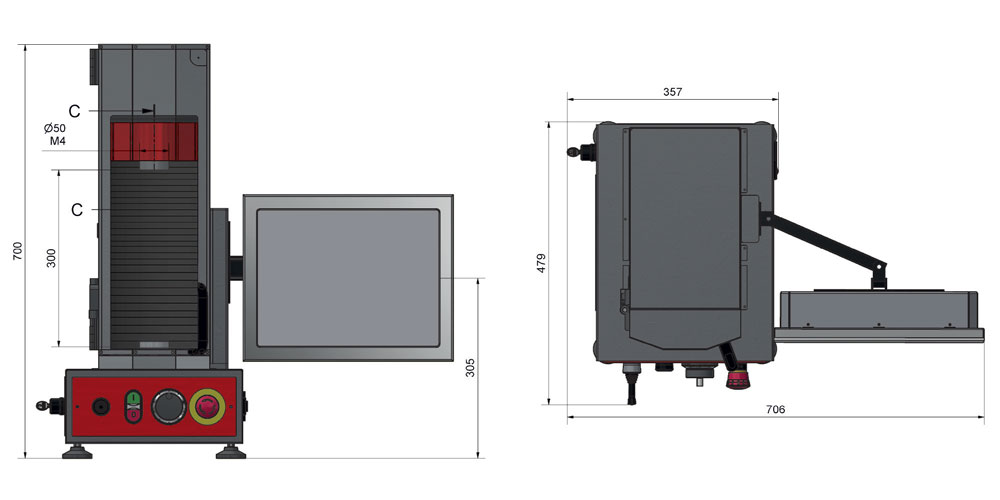
WHICH ARE THE MAIN FIELDS EMPLOYING A BENCH SPRING LOAD TESTER?
Spring testing in medical sector
Springs play a key role in medical devices, including pumps, surgical instruments, actuators, breathing support devices and prostheses of various types. In the medical sector, which is constantly developing, compliance with regulations and strict controls are vital. Therefore, conducting tests on springs and materials is a mandatory requirement that cannot be neglected.
Medical devices require the use of springs that guarantee precise and consistent performance. For example, springs are used in pumps to control and regulate the flow of liquids or gases in the device. Surgical instruments require precise high-quality springs to perform specific functions, such as pressure regulation or joint management. Actuators, which are essential components in various medical devices such as robotic prostheses, depend on efficient springs to transform energy into controlled, repetitive movement. Spring test benches are ideal for testing these kinds of products, characterised by small dimensions and low working forces.
Breathing support devices, such as respirators and ventilators, make extensive use of springs to ensure the proper operation of valves, diaphragms and pressure regulation mechanisms. Prosthetics, which may involve different parts of the body such as artificial limbs or dental implants, require the use of springs to provide support and flexibility in various applications.
Testing of springs in the firls of electronics, electrical engineering
The electronics and electrical engineering sectors make extensive use of small springs in a variety of devices. In electronic devices, springs perform several functions. Spring switches, for example, use springs to provide a tactile response and mechanical return when pressed. Keyboards, which may be found in computers, mobile phones or other devices, use springs to provide movement and feedback when keys are pressed. Electronic component connectors can make use of springs to ensure a stable and secure connection. The microswitches of many electronic devices use springs to regulate the electrical contact when activated.
Moreover, springs are also used as shock-absorbing components in sensitive electronic devices. These springs help protect the internal components from damaging impacts or vibrations, ensuring the stable and reliable operation of the device.
It is therefore vital to carry out a complete characterisation of the springs involved. This process is essential for the successful production of millions of units of a single product, to make sure that they are free of defects that would compromise entire production lots.
Aerospace industry
Small springs are used in several crucial applications of the aerospace sector. Springs are used as components of clamping systems to ensure the stable positioning of moving parts, such as panels, doors or covers, during the operation of spacecraft, aircraft or satellites. They guarantee a secure and reliable seal, allowing the correct functioning and protection of internal components. For this reason, a very high level of accuracy and repeatability is required when testing aerospace springs.
Aerospace control systems may include springs to provide tension, flexibility or reaction within complex mechanisms such as flight controls. Springs are used to ensure precise and reliable responses to the actions of operators or automated controls, contributing to the stability and manoeuvrability of the aircraft or spacecraft. When the forces involved are small, i.e. below 50 kg, and require precision machinery, a benchtop spring testing instrument is the winning choice.
In addition, springs are used in vibration damping systems to reduce unwanted oscillations caused by vehicle movement or operation. These systems use specially designed springs to absorb and dissipate vibration energy, improving passenger comfort and the durability of shock-sensitive components.
Jewellery sector: how to test watches springs?
In this field, springs play an essential role in the opening and closing mechanisms of wristwatches, brooches, bracelets, necklaces, pendants and other jewellery.
In wristwatches with classic mechanisms, springs of various types, always with a very low load, are used both in the joints and the clasp systems of watch bracelets.
Springs may also be found in the clasps of jewellery bracelets. to ensure that they fit the wrist correctly and guarantee the security of the item.
The choice of springs in jewellery is important not only for the functionality of the mechanism, but also for the quality and overall look of the jewellery. Springs must be carefully designed, a process that requires several spring testing stages, followed by mass-production using high-quality materials that resist wear and can provide constant tension over time.
Optics
In the field of optics, springs are used in the manufacture of a large number of instruments such as microscopes, telescopes, binoculars and optics for photography or industrial applications. Here, springs are used in focusing mechanisms, to allow precise and gentle adjustment of the lens or eyepiece for sharp and well-focused images, and ensure constant tension for a smooth and controlled focusing action. Tests on this type of high-precision springs are very important to ensure the quality of the products of the optics sector.
Laboratories carrying out research and development on springs for the optical sector, both for the end consumer and industrial use, often make use of Easydur benchtop spring testing machines to ensure maximum characterisation of the prototypes of new springs and to carry out spot checks on the different spring lots, but also for quality control in the production of low to medium volumes of springs.
